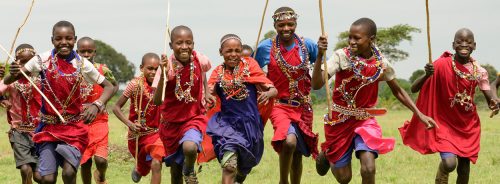Last week brought incredible leopard sightings, but this week was even more remarkable as we struck gold with a mating pair. Witnessing such an event in the wild is an exceptionally rare and special moment during a safari. Leopards, notoriously solitary creatures, are only seen together when a mother is with her cubs or during mating, as in this case.
We were thrilled to see the elusive Osidai with a seemingly reserved female, who would occasionally dart in and out of view, keeping us waiting with bated breath. Patience was essential, and we were more than willing to wait. She displayed submissive behaviour as she approached Osidai, enticing him by rubbing against him, crouching low, and raising her tail.
Her actions became increasingly persistent, and she rubbed against nearby shrubs to signal her interest. Despite her efforts, Osidai seemed indifferent, growling occasionally while we kept our cameras ready to capture this rare encounter's fascinating dynamic.
Eventually, her persistence was irresistible, and Osidai responded to her cues as he mounted the female. While the mating is brief, lasting only a few seconds, it occurs repeatedly over several days. The male leopard's barbed penis, which plays a crucial role in inducing ovulation, causes significant discomfort to the female. This pain triggers her instinctive reaction to lunge at him, claws bared. This dramatic reflex signifies the physical strain of mating — anticipating this, Osidai quickly leaps backwards, skilfully avoiding her sharp, dagger-like claws.
Among Africa's most formidable avian predators, martial eagles are extraordinary hunters. Their exceptional eyesight enables them to detect prey from great heights, striking with remarkable speed and precision. We noticed this efficiency when we encountered a martial eagle flying to a tree, clutching its reward — a red-necked spurfowl that stood no chance against this apex predator.
The Nyati Boys certainly live up to their name by consistently hunting buffalo, or 'Nyati' in Swahili. Their ability to take down buffalo is a testament to their hunting prowess and teamwork, as these lions rely on hunting large prey to sustain themselves. Known for their strength and defensive nature, buffaloes are among the most dangerous animals to hunt, even for apex predators.
After successfully killing a massive buffalo during the night, the Nyati Boys were forced to retreat at dawn when the rest of the herd arrived to inspect their fallen member — though it was too late to save it.
The Nyati Boys seem to be doing well with a new litter in their territory from two females whose pride affiliation is still unclear. Though reduced to four from five, the cubs seem to be thriving under the care of their mother, aunt and the Nyati Boys. It will be interesting to see how the cubs continue to grow and whether the two females will eventually reveal which pride they belong to.
Near the Purungat Bridge, we encountered the four Inselberg males — Manywele, Nusu, Ruka, and Ginger. These adventurous lions have been extending their range, venturing further from their usual territory. A few weeks ago, it was reported that they had crossed the Mara River into the Greater Mara, but they have since returned to the Triangle. Their movements suggest they may be testing boundaries or scouting for new opportunities. —Robert Sayialel
This week was a bit different at Angama Amboseli. The guides were sent on a training course to sharpen their skills ahead of 2025, while the lodge undergoes some improvements.
A few days before the training began, Guide Jeremy was on a safari with a guest in Kimana Sanctuary. While explaining how elephants typically sleep — often taking short 'naps' while leaning against sturdy trees — he mentioned how rare it is to see them lying down. Moments later, they rounded a bend and stumbled upon an extraordinary sight: four elephants lying down, seemingly relaxed and asleep. This rare behaviour suggests they felt completely safe and calm, with the rest of the herd standing guard nearby.
While phones and cameras were discouraged during the training course to ensure complete focus, Guides Jeremy and Salash captured a few moments between lessons. In awe of their surroundings, they observed fascinating wildlife behaviours, though, to their dismay, tracking lion footprints was challenging as the rain continued to wash away their tracks.
One afternoon, the Guides witnessed an extraordinary sight: two kudus mating, surrounded by herds of other wildlife. Although kudus are widespread in the area, they are elusive, making such encounters rare and truly special.
While walking, the Guides came across a zebra carcass; there were no signs of a struggle, suggesting it likely died of natural causes, possibly old age. This was the ideal meal for white-backed and Rüppell's vulture, as they had no predators to compete with. Most zebras typically live 20–25 years, though their lifespan can be shortened by predation, disease, or habitat loss.
Kimana Sanctuary thrives with elephants, including four magnificent Super Tuskers currently roaming among the herds. On one particular outing during training, the group found themselves surrounded by elephants. They approached a small hill to get a better view from higher ground but quickly realised there was no clear path forward, so they had to retreat.
Heading to Amboseli National Park was no different. The Park, too, boasts herds of elephants, always offering the perfect opportunity to snap photos of two of Kenya's most beloved giants (Kili and the pachyderms). Feeling a sense of calm throughout the vast park, stopping alongside Lake Amboseli can take hours of your day as you watch a variety of birds enjoy a swim, like this reed cormorant (also known as the long-tailed cormorant) that was seen coming in for a smooth landing. —Japheth Supeyo
Filed under: This Week at Angama
Subscribe for Weekly Stories
Comments (0):

The Angama Foundation